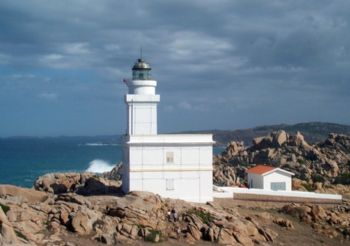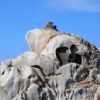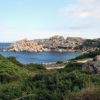
Promontory of Capo Testa
shaped granite rocks spectacular
From the center of Santa Teresa Gallura, along a beautiful panoramic road about five kilometers long, you reach this promontory, characterized by granite rocks spectacular forms, so-called tafoni, recalling sometimes animals, sometimes human faces.
But it's also nice to scrutinize these stones polished by the wind and the sea and discover new forms, new subjects, stimulating their imagination, their imagination.
At Capo Testa are noticed numerous remains of abandoned quarries that first the Romans exploited for the extraction of granite used in the construction of their buildings in the capital, such as the Pantheon. Capo Testa is connected to the mainland by a narrow isthmus whose sides welcome the beaches of Rena di Levante, on the one hand, and Rena di Ponente-Baia Santa Reparata other; these two sides always allow the calm sea from one of the two sides, depending on the wind direction.
Going through to the end of the road that goes into the promontory you reach the Lighthouse of Capo Testa from where, on foot, you can follow one of the trails that descend to the sea, like the one that goes down to the beach of Cala Spinosa.
Capo Testa is also a gym for fans of free climbing, from the novice to the most capable. The most interesting areas are located in the charming seaside Valle della Luna, the granite massif of Punta della Torre, accessible by the road that leads to the parking lot of Rena Ponente, right after the Isthmus.
After about one kilometer turn right at a resort, they drive another 200 meters. before turning left again for a path that in about ten minutes to the valley. The sea side of the tip engages in climbing classic and full of streets, called Wall of the Moon.
This area is also known to be frequented by young and old, who for years actually inhabit this stretch of coast, climb on these rocks that make up their "home", animated by an alternative lifestyle and due to a sort of "children flowers "60s / 70s.
Capo Testa offers an extraordinary underwater landscape, rich in caves and ravines on which grow fans and, to a greater depth, even corals.
Dive as simple as striking is that the left of the lighthouse, at a distance of a hundred meters from the coast, leading to a depth of about -10, where it meets the wreck of a ship stranded on the rocks and sunk in the years seventy.
But it's also nice to scrutinize these stones polished by the wind and the sea and discover new forms, new subjects, stimulating their imagination, their imagination.
At Capo Testa are noticed numerous remains of abandoned quarries that first the Romans exploited for the extraction of granite used in the construction of their buildings in the capital, such as the Pantheon. Capo Testa is connected to the mainland by a narrow isthmus whose sides welcome the beaches of Rena di Levante, on the one hand, and Rena di Ponente-Baia Santa Reparata other; these two sides always allow the calm sea from one of the two sides, depending on the wind direction.
Going through to the end of the road that goes into the promontory you reach the Lighthouse of Capo Testa from where, on foot, you can follow one of the trails that descend to the sea, like the one that goes down to the beach of Cala Spinosa.
Capo Testa is also a gym for fans of free climbing, from the novice to the most capable. The most interesting areas are located in the charming seaside Valle della Luna, the granite massif of Punta della Torre, accessible by the road that leads to the parking lot of Rena Ponente, right after the Isthmus.
After about one kilometer turn right at a resort, they drive another 200 meters. before turning left again for a path that in about ten minutes to the valley. The sea side of the tip engages in climbing classic and full of streets, called Wall of the Moon.
This area is also known to be frequented by young and old, who for years actually inhabit this stretch of coast, climb on these rocks that make up their "home", animated by an alternative lifestyle and due to a sort of "children flowers "60s / 70s.
Capo Testa offers an extraordinary underwater landscape, rich in caves and ravines on which grow fans and, to a greater depth, even corals.
Dive as simple as striking is that the left of the lighthouse, at a distance of a hundred meters from the coast, leading to a depth of about -10, where it meets the wreck of a ship stranded on the rocks and sunk in the years seventy.
-
Indirizzo: Promontorio di Capo Testa
-
Località: Santa Teresa Gallura
-
Search











